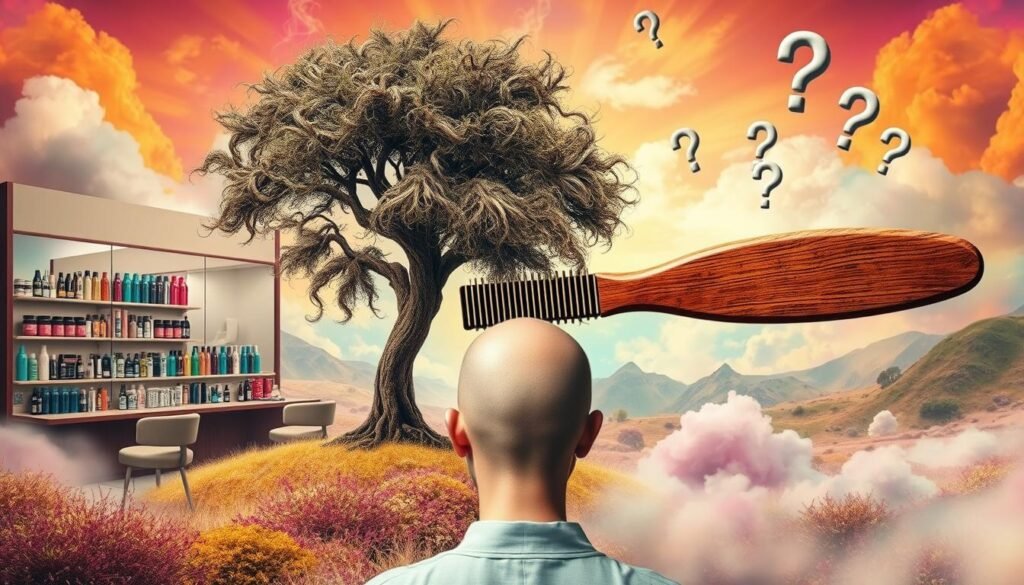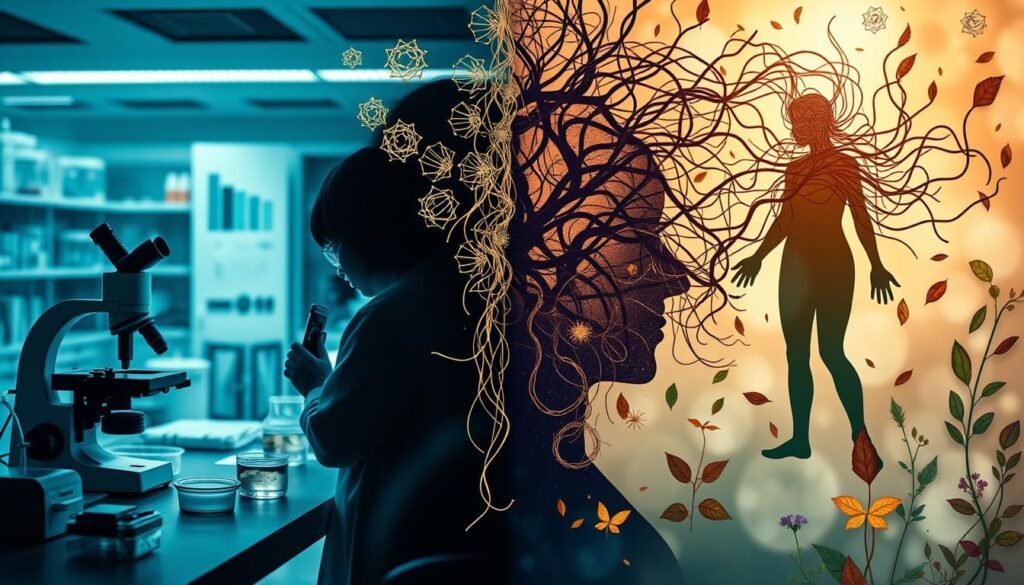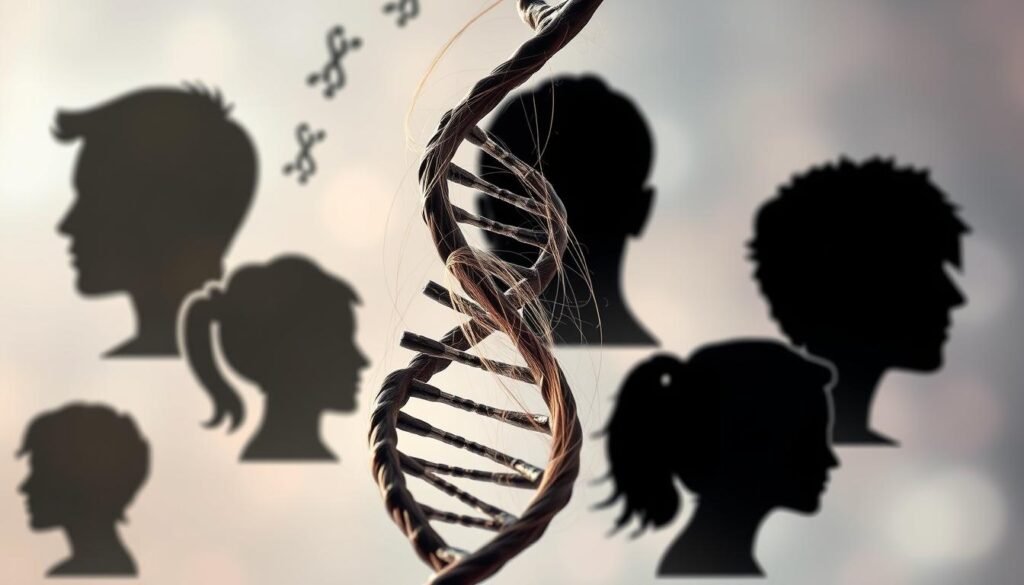Did you know around 2% of people worldwide have alopecia areata? This condition can lead to sudden hair loss. Despite its global impact, there are many myths surrounding alopecia. Today, it’s more important than ever to understand the real facts.
With so much information about alopecia, we must find the truth. This article will guide you through the science. It tackles myths and shows what research says about treating alopecia. Let’s explore the facts together.
Key Takeaways
- The global prevalence of alopecia areata affects around 2% of individuals worldwide.
- Understanding alopecia requires distinguishing scientific facts from common misconceptions.
- Current research provides clear insights into effective treatment options for alopecia.
- Educational efforts are crucial in combating myths about hair loss and conditions like alopecia.
- A broad range of factors, including genetics and lifestyle, influence the onset of alopecia.
- Empowering individuals with accurate information helps foster a supportive community for alopecia sufferers.
Understanding Alopecia: The Basics
Alopecia is known as hair loss and comes in different forms. Knowing about alopecia is key for those who lose hair. It helps identify the hair loss type and find the right treatment. Each type of hair loss has unique features and causes.
What is Alopecia?
Alopecia means hair loss for people of any age or gender. Its impact can range from slight hair thinning to total baldness. Knowing all about this condition is the first step in managing it effectively.
Types of Alopecia
Several hair loss types fall under alopecia:
- Androgenetic Alopecia: Also known as pattern baldness, it’s inherited and follows a predictable loss pattern.
- Alopecia Areata: This autoimmune disorder leads to sudden hair loss, often in patches, for both genders.
- Telogen Effluvium: Stress, hormonal shifts, or medical issues can trigger this temporary but significant hair shedding.
These varieties of hair loss show distinct characteristics and affects. They change how individuals experience alopecia.
Symptoms and Diagnosis
Noticing alopecia’s symptoms is key to diagnosing it. Common signs include:
- Gradual thinning atop the head
- Patchy bald spots
- Hair that easily comes loose
For diagnosing alopecia, doctors might examine your scalp and hair. Blood tests or a scalp biopsy can pinpoint the hair loss cause. Early symptom recognition helps start treatment and management quickly.
Science vs. Myths: Common Misconceptions About Alopecia
Understanding truth vs. myths about alopecia helps us support those who have it. Many alopecia myths exist. They lead to misunderstanding and stigma. Two big myths are about who gets hair loss and what alopecia really is.
Myth 1: Hair Loss Only Affects Older Adults
Some think only older adults lose hair. But, hair loss demographics show it can happen at any age. Studies show hair loss can start in youth, affecting both boys and girls. This fact shows why we need more awareness and support, for everyone.
Myth 2: Alopecia is a Contagious Condition
Some believe you can catch alopecia from others. This is not true. Alopecia is an autoimmune condition, not something you can catch. Clearing up this myth helps reduce stigma and creates a better understanding for everyone.

| Myth | Truth |
|---|---|
| Hair loss only affects older adults | Alopecia can begin at any age, affecting all genders. |
| Alopecia is contagious | Alopecia is an autoimmune disorder, not an infectious condition. |
Debunking Myths: Evidence-Based Insights
Research is key in understanding alopecia. Many studies provide insights into its causes and treatments. They help clear up common myths about hair loss.
Research Studies on Alopecia
A recent study in the Journal of Investigative Dermatology looked at genetics and the environment’s role in hair loss. It shows why it’s crucial to see alopecia as unique to each person.
Myth-Busting Techniques
Myth-busting techniques correct false information about alopecia. Experts use scientific facts in their efforts. Public campaigns and seminars spread truth, helping people tell facts from myths.

| Study Title | Findings | Source |
|---|---|---|
| Genetics of Alopecia Areata | Identified specific genes linked to susceptibility. | Journal of Investigative Dermatology |
| Effect of Stress on Hair Loss | Examined the correlation between stress levels and alopecia onset. | American Journal of Clinical Dermatology |
| Nutrition and Hair Health | Highlighted the impact of nutritional deficiencies on hair loss. | Nutrition Research Reviews |
The Role of Genetics in Alopecia
Alopecia is a condition often shaped by genetics. Knowing about these genes helps us understand the risk of inheriting hair loss. Research shows how certain genes make people more prone to different alopecia types. Here, we look into the key genetic reasons behind hair loss and what a family history of alopecia means.
Genetic Factors Contributing to Hair Loss
Studies show a strong link between genes and alopecia. These genes affect how hair follicles grow and stay healthy. It’s not about one gene, but many that work together. They influence hormones, the immune system, and hair growth cycles. This info helps explain why hair loss varies from person to person.
Family History and Alopecia
Having family members with alopecia can signal your own risk. If your relatives have faced hair loss, you might too. Looking at family patterns helps assess how likely you are to have similar issues. It encourages steps for early care and seeking advice based on your genes.

Environmental and Lifestyle Factors
Understanding how outside elements affect hair is key in tackling alopecia. The role of environmental factors is huge, especially stress and diet. These have a big impact on hair health, so knowing about them is crucial.
Stress and Its Impact on Hair Health
Stress can cause hair to fall out and worsen hair health. Studies show a clear link between stress and hair loss. Stressful situations may push hair follicles to pause, leading to hair loss. Trying out stress-reducing activities like meditation, exercising, and being outdoors can help.
Nutritional Deficiencies Linked to Alopecia
Not getting enough nutrients affects hair growth and health. Lacking iron, zinc, and important vitamins can make hair loss worse. Eating well is key. Foods rich in biotin, vitamin D, and some B vitamins are vital for hair. People with alopecia should check their diets to make sure they’re getting what their hair needs.
| Nutritional Elements | Effect on Hair Health |
|---|---|
| Iron | Supports oxygen transport to hair follicles; deficiency may lead to hair thinning. |
| Zinc | Essential for hair tissue growth and repair; lack of zinc can impede hair growth. |
| Biotin | Important for keratin synthesis; deficiency linked to hair brittleness and loss. |
| Vitamin D | Regulates hair follicle cycle; low levels associated with increased hair shedding. |
| B Vitamins | Contribute to healthy hair growth; deficiencies may lead to hair loss. |
Separation of Fact from Fiction: What the Scientific Evidence Says
Understanding alopecia means digging into a lot of facts and myths. Recent studies give us a clearer picture about hair loss causes. We now have insights from experts and research that guide us through this condition.
Current Research Findings
Studies on alopecia reveal it’s vital to know the causes, like genes, hormones, and environment. Research on treatments shapes expert advice on managing alopecia. For example, testing medicines like finasteride and minoxidil has shown good results for some people.
Expert Opinions in Dermatology
Dermatologists suggest a careful method in diagnosing and treating alopecia. They stress on custom treatment plans for each person. Combining new therapies with proven ones aims for the best hair recovery. This ensures patients get care based on solid research evidence.
Treatment Options: What Works and What Doesn’t
Exploring the different treatments for alopecia is key. It helps people understand what might work for them. There are various methods with different results and side effects. From traditional to holistic remedies, evaluating these options is crucial.
Popular Treatments Explored
Some top treatments for hair loss include corticosteroids, minoxidil, and hair transplants. Each has its pros and cons.
- Corticosteroids: These are anti-inflammatory medications. They can be injected or used topically to help hair grow back.
- Minoxidil: A topical solution known for stimulating hair growth. It’s often used for male and female pattern baldness.
- Hair Transplantation: In this surgery, hair follicles are moved from one spot to bald areas. It offers a lasting fix for some people.
Alternative Approaches to Alopecia Management
Aside from conventional treatments, many seek alternative ways to manage hair loss. Herbal remedies and changing your lifestyle are key parts. It’s vital to check their scientific validity.
- Herbal Remedies: Ingredients like saw palmetto and ginseng are thought to improve hair health. However, their scientific proof varies.
- Dietary Changes: Eating foods high in vitamins and minerals can help hair health. It addresses possible deficiencies.
- Stress Management: Doing yoga and meditating can reduce stress, which may lead to hair loss.
Always look into the credibility of alternative treatments with medical research. For deeper insights into proven approaches, visit this resource. Knowing which treatments are reliable helps in making smart choices about hair restoration.
Dispelling Myths: Real Stories from Alopecia Sufferers
Living with alopecia is a deeply personal journey. It shows the resilience and strength of those affected. Stories of alopecia bring to life the emotional and psychological impacts of hair loss. They highlight not just the hardships but also the victories. These stories remind us of the importance of community support, where individuals find comfort and understanding.
Personal Experiences and Community Support
Many people share their alopecia stories in groups and forums. They often talk about feeling isolated and confused at first. But connecting with others who have alopecia brought them solace and a sense of belonging. Community support initiatives foster friendships and offer encouragement, helping people embrace their identities beyond their hair.
Support groups provide invaluable experiences. Here, members exchange strategies for coping and create a supportive environment. These communities help in healing, reminding everyone that they’re not alone.
Awareness and Education Efforts
Raising awareness about alopecia goes beyond sharing stories. It requires educating the public and dispelling myths. Awareness efforts are crucial for informed conversations and promoting empathy. Campaigns feature firsthand accounts that challenge stereotypes and deepen understanding of hair loss experiences.
But it’s not just individuals who tell these stories. Organizations and advocates play a big role in raising awareness. They create platforms for dialogue and workshops aimed at reducing stigma. For those looking into the science of hair health misconceptions, this research article offers more insights.
Conclusion
This article highlights the big differences between real science and common myths about alopecia. People should think critically about this topic. It’s important to rely on evidence when learning about hair loss.
The comparison between science and myths emphasizes the need for ongoing education on alopecia. As we talk more about hair loss, our knowledge of its causes, treatments, and the support available should also grow.
In closing, it’s key to show kindness and understanding towards those with alopecia. They need our support and the right information to help them. This is why separating true scientific facts from myths is vital. For more info, check here.